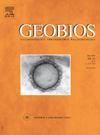欧洲西南部更新世末期:从海因里希事件3到普拉德斯山脉(伊比利亚半岛东北部)末次盛冰期的鸟类组合
IF 1.6
4区 地球科学
Q2 PALEONTOLOGY
引用次数: 0
摘要
对从考古遗址中恢复的鸟类群落的研究提供了古气候和环境信息,以及形成过程和作用于它们的因素的数据。本文介绍了在伊比利亚半岛东北部两个遗址中发现的7个鸟类组合的古生物学和地语学分析结果:Galls Carboners (GC);31,380-31,170 cal. BP)和Cudó (CU;CU107 31,245-24,404 cal. BP和CU105 15,585-10,199 cal. BP)。GC105、GC106、GC107、GC108 4个不同的组合对应于Heinrich事件3,只有3个不同的分类群,以Columba的存在为主。这些遗骸大多属于未成熟的个体。在CU,我们研究了对应于Heinrich 3、Heinrich 2和末次盛冰期的两个组合(CU107-CU105),它们的分类多样性与GC相似。组合CU105表现出最大的多样性,其中小通道形目是最丰富的分类群。特别令人感兴趣的是CU107中cf. Pinicola去核体的存在,目前在该地区不存在,但在北方地区存在。地形学结果表明,这两个位点(GC和CU)的积累来源都是自然死亡。此外,不同的因素改变了这些聚集:小型食肉哺乳动物和夜间猛禽影响了GC的聚集,而夜间和白天的猛禽可能是在CU站点记录的鸟类的主要捕食者。GC和CU的海因里希3组尽管存在差异,但多样性程度相似,以岩石居群为主。这可能与海因里希事件3期间该地区的恶劣环境有关,而不是地语学上的偏见。更多样化的CU105组合表明LGM后生态系统恢复。本文章由计算机程序翻译,如有差异,请以英文原文为准。
The end of the Pleistocene in south-western Europe: The avian assemblages from Heinrich event 3 to the Last Glacial Maximum in the Prades mountains (north-eastern Iberian Peninsula)
The study of bird assemblages recovered from archaeological sites provides palaeoclimatic and environmental information, as well as data on the formation processes assemblages and the agents that have acted upon them. In this paper, we present the results of palaeontological and taphonomic analysis of seven avian assemblages recovered from two sites located in the north-eastern Iberian Peninsula: Galls Carboners (GC; 31,380–31,170 cal. BP) and Cudó (CU; CU107 31,245–24,404 cal. BP and CU105 15,585–10,199 cal. BP). GC has yielded four different assemblages (GC105, GC106, GC107, GC108) corresponding to the Heinrich event 3, with only three different taxa, dominated by the presence of Columba. Most of these remains belong to immature individuals. At CU, we studied two assemblages (CU107–CU105) corresponding to Heinrich 3, Heinrich 2 and the Last Glacial Maximum with a similar taxonomic diversity to GC. Assemblage CU105 exhibits the greatest diversity, and small Passeriformes are the most abundant taxa recorded. Of particular interest is the presence of cf. Pinicola enucleator in CU107, today absent in the area and present in boreal areas. Taphonomic results suggest that the origin of accumulations for both sites (GC and CU) was natural death. In addition, different agents modified these accumulations: small carnivorous mammals and nocturnal raptors affected GC’s assemblages, while nocturnal and diurnal raptors would have been the main predators of the birds documented at the CU site. Despite the differences between the accumulations, Heinrich 3 assemblages from GC and CU show a similar low degree of diversity, dominated by rock-dwelling taxa. This may be related to the harsh environment of the area during Heinrich event 3, and not to a taphonomic bias. The more diverse assemblage of CU105 points to an ecosystem recovery after the LGM.
求助全文
通过发布文献求助,成功后即可免费获取论文全文。
去求助
来源期刊

Geobios
地学-古生物学
CiteScore
3.30
自引率
6.20%
发文量
28
审稿时长
6-12 weeks
期刊介绍:
Geobios publishes bimonthly in English original peer-reviewed articles of international interest in any area of paleontology, paleobiology, paleoecology, paleobiogeography, (bio)stratigraphy and biogeochemistry. All taxonomic groups are treated, including microfossils, invertebrates, plants, vertebrates and ichnofossils.
Geobios welcomes descriptive papers based on original material (e.g. large Systematic Paleontology works), as well as more analytically and/or methodologically oriented papers, provided they offer strong and significant biochronological/biostratigraphical, paleobiogeographical, paleobiological and/or phylogenetic new insights and perspectices. A high priority level is given to synchronic and/or diachronic studies based on multi- or inter-disciplinary approaches mixing various fields of Earth and Life Sciences. Works based on extant data are also considered, provided they offer significant insights into geological-time studies.
 求助内容:
求助内容: 应助结果提醒方式:
应助结果提醒方式:


